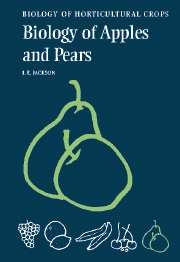Book contents
- Frontmatter
- Contents
- Preface
- Acknowledgements
- Introduction
- 1 The growing of apples and pears
- 2 Apples and pears and their relatives
- 3 Apple and pear root systems: induction, development, structure and function
- 4 The graft union, grafting and budding
- 5 Mechanisms of rootstock and interstock effects on scion vigour
- 6 The shoot system
- 7 Leaves, canopies and light interception
- 8 Photosynthesis, respiration, and carbohydrate transport, partitioning and storage
- 9 Flowers and fruits
- 10 Eating quality and its retention
- 11 Mineral nutrition
- 12 Water relations
- 13 Diseases, pests, and resistance to these
- 14 Biotechnology of apples and pears
- Cultivar Index
- General Index
- References
- Frontmatter
- Contents
- Preface
- Acknowledgements
- Introduction
- 1 The growing of apples and pears
- 2 Apples and pears and their relatives
- 3 Apple and pear root systems: induction, development, structure and function
- 4 The graft union, grafting and budding
- 5 Mechanisms of rootstock and interstock effects on scion vigour
- 6 The shoot system
- 7 Leaves, canopies and light interception
- 8 Photosynthesis, respiration, and carbohydrate transport, partitioning and storage
- 9 Flowers and fruits
- 10 Eating quality and its retention
- 11 Mineral nutrition
- 12 Water relations
- 13 Diseases, pests, and resistance to these
- 14 Biotechnology of apples and pears
- Cultivar Index
- General Index
- References
Summary
Introduction
The configuration and productivity of the individual apple or pear tree is determined by its height, the number and length of its branches and the angle of these to the vertical.
The size, density and arrangement of the branch and shoot framework determine the leaf area and light capture, and hence potential photosynthesis. They also determine the number of fruit buds and fruits.
Manipulation of shoot growth begins in the nursery, with the objective of producing trees with numerous lateral branches capable of bearing fruits in their early years in the orchard. It continues throughout the life of the tree with emphasis in the early years on branch initiation, development and training, followed by emphasis on the renewal of fruiting wood and ensuring adequate penetration of light into the canopy.
The stages in the development of an apple tree and the key elements of its above-ground structure are shown in Figure 6.1. Other tree forms may be used but the essentials are the same for both apples and pears.
Buds
All shoots of apple and pear scions arise from buds. The first in the life of the tree is the bud which is inserted into the rootstock stem by budding or is present on scionwood grafted on the rootstock. The buds on the orchard tree can be on the long (extension) shoots or the short (spur) shoots and may be terminal, i.e. at the end of the shoot, or lateral, i.e. in the axil of a leaf.
- Type
- Chapter
- Information
- The Biology of Apples and Pears , pp. 157 - 209Publisher: Cambridge University PressPrint publication year: 2003
References
- 2
- Cited by



